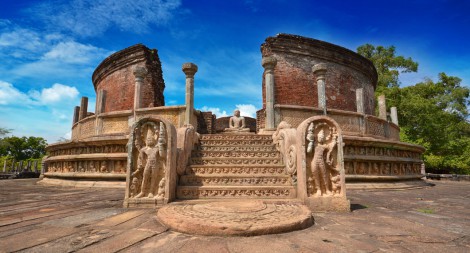It was the second capital of Sinhala Kingdom between 10th and 12th century and known as the fifth administrative center of the kingdom of Rajarata. Polonnaruwa was constructed after the destruction of Anuradhapura in 993 on the left side of the bank of the main river Mahaweli. The city prospered as a Buddhism center and many monks from Thailand and Burma visited the city.
Currently the city is dived in to two main areas as a “new town” in Kaduruwela area where commercial activities are taken place while other part of Polonnaruwa remains as the royal ancient city of the Polonnaruwa kingdom by keeping its archaeological values.
When you arrive in Polonnaruwa, the first thing you notice is a gigantic water reservoir looks has a scale of ocean, called the Parakrama Samudra or the Sea of Parakrama. It was created by king Parakrama the Great, governed this island when constructing the city to facilitate water reservoir and channel for irrigation while the city was flourishing with trade and agriculture. To this day, this water helps to supply for paddy cultivation during the dry season and important resource for people in Polonnaruwa.

An ancient royal city with archaeological values
It’s an ancient city in Sri Lanka. There are three sections in Polonnaruwa; Old Town, New Town, and Kaduruwela.
Potgul Vihara:
It was a library monastery.
Statue of Unknown Man or The Sage:
It is a statue of a man holding Buddhist scriptures written on palm leaves. About 3.6 meters high and was printed on Rs.10 bill. The person is supposed to be one of the kings who brought the most prosperity to Polonnaruwa.
Polonnaruwa Museum:
An excellent place to see displays on life and exhibitions including Chola bronzes in the ancient city.
The Royal Palace:
It is a ruin of palace that was used to be a 7-story building, but only 3-story remains. The thickness of the wall was 3 m and the 36 poles were supporting the roof. This palace had 50 rooms. There is also a ruin of King’s Council Chamber where you can see the names of ministers on each stone pole. Audience Hall was used by Parakrama Bahu I. The bath place, Kumara Pokuna, was for Prince Nissankamalla.
Siva Devalaya No.1:
It was a Hindu shrine built in 13th century. The design was influenced by Indian culture.
Quadrangle:
There are collections of 11 buildings inside of the four square castellated wall.
Pabalu Vihara:
A small pagoda created by Queen in 12th century.
Siva Devalaya No. 2:
It was constructed by Tamil of Chola dynasty came from India during 11th century.
Rankot Vihara:
The meaning of the name is Golden Pinnacle. It is the largest building in Polonnaruwa with 55 m height and 55m diameters, constructed by King Nissanka Malla in 12th century.
Gopala Pabhata:
It is a stone shrine from 2-5 B.C.
Lankatilaka:
This temple with 17.5 m height, 52 m depth, 18 m width was built by Parakramabahu the 3rd in 3rd century and restored by Vijayabahu the 5th in 5 century. In side of the ruin, there is a gigantic stunning Buddha statue.
Kiri Vihara:
Kiri means milk. Just like the name, it is a white pagoda was buried in the deep jungle more than 700 years. It was built by Queen Subhadra, the wife of Parakramabahu the 1st.
Gal Vihara:
Stone statues of three Buddhists; a 4.6 m, a 7 m, and a 14 m height.
Demala Maha Seya:
This was a site for a run that was to create the largest pagoda, but it failed. It was used to hold captives from the war with King Parakrama Bahu and South Indian troops.
Lotus Pond:
This ruin used to be a bath place for monks.
Tivanka Image House:
Tivanka means a pose to bent a body in three. It is the 13th century mural painting of Buddha, bending three opposite ways for hip and neck.
Entrance fee: Rs. 3,250 (US$ 25)
Hours: 8am - 5pm
Bicycle rental: Rs.300 - 500 per day
Three Wheeler: Rs.1200~ per day